This is the latest in our Guide to Cloth series – setting out the basics for what makes a good trouser, and the material options. The Guide has more in-depth articles on summer trousers, flannel, and other cloth basics. Available in the menu under ‘Guides’ and here.
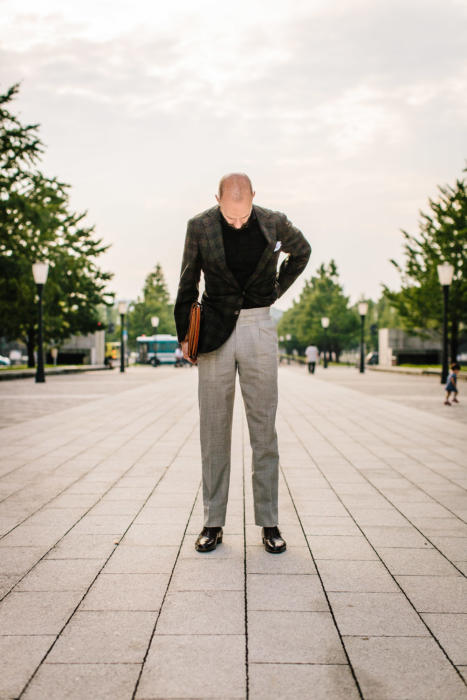
What makes a good trouser? Why do some cloths work well, and others not?
And from a style point of view, which of the different ‘types’ are more and less formal?
When readers start to move from suits towards separate jackets and trousers, these quickly become questions that bother them. Particularly if they’ve paid hundreds of pounds to have trousers made, and they’re not quite right.
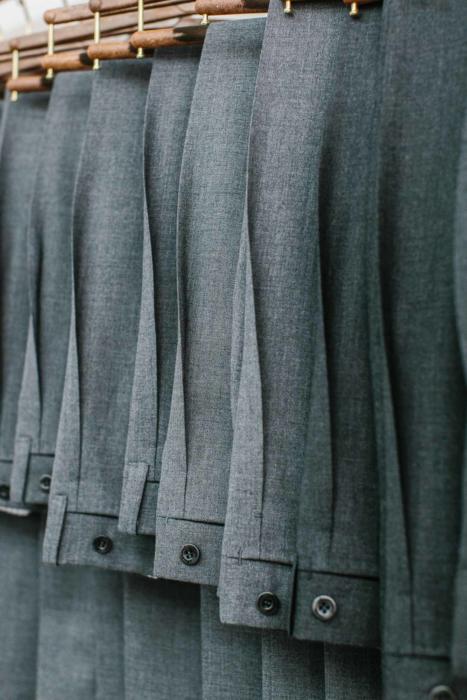
The key attribute of trousers is that they hang well.
Trousers are not shaped around the shoulders or the chest. They’re largely just cut for the hips or waist, and left to hang.
So they need to drape cleanly and consistently, throwing a nice sharp line and retaining it when bent and stretched, as the user walks, stretches and sits.
Technicians sometimes divide this into three attributes: crease resistance, shape resistance (not bagging at the knees, despite pressure), and some natural stretch (which allows the cloth to return to its shape after that pressure).
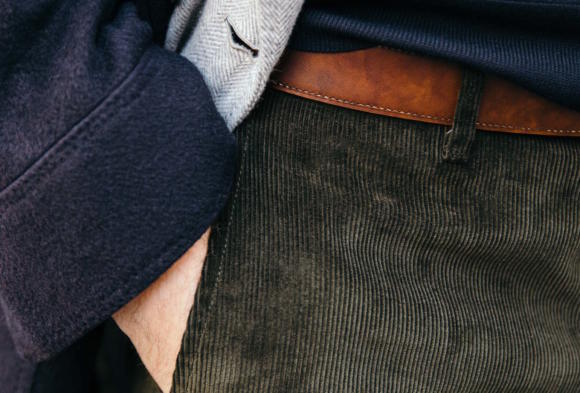
This usually comes from a cloth that is denser, with more of the yarn woven tightly into every inch. This is the advantage of weaves such as twill, for example, which are naturally denser.
Cloths created for womenswear often noticeably lack this. They’re loosely woven, to flow and sometimes shape around the body, but lose their shape under pressure.
There are exceptions. For example, if the yarn is particularly strong, the weave doesn’t have to be so dense. This is the case with linens and with high-twist wools. The strength of the yarn means they can use a looser, plain weave, which still retains drape with the bonus of allowing air to pass through.
And fabrics can be too dense. If there’s too much fibre in there, they can feel stiff and ‘dead’. Technicians talk about holding the cloth in the hand, squeezing and releasing it to see how it reacts – how much ‘life’ there is.
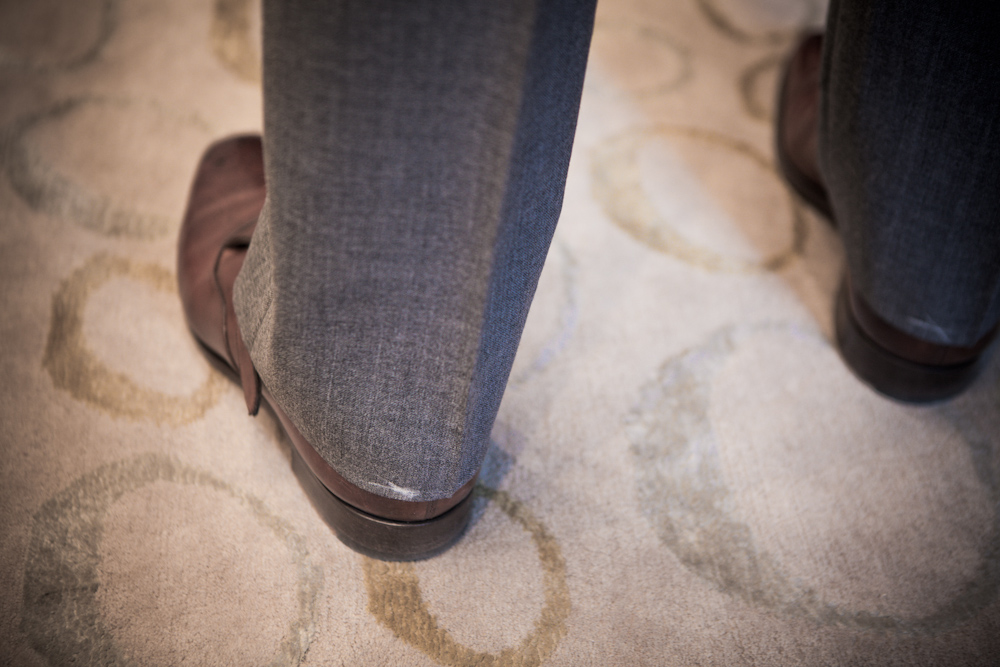
But density is still a good rule of thumb. That’s why you often find bunches of high-twist wools divided into ones for trousers and suits, and others for jackets.
Those made specifically for sports jackets are usually softer, looser and have a more open weave. You can hold it between two hands, move each up and down, and feel the movement the cloth has. It would not make good trousers.
The same goes for a lot of wool/silk/linen cloths. They’re a little too open and loose. Over the course of a day they’ll lose their shape, and over the course of a year will wear through. Or the seam in the seat will tear open.
Trousers are worn a lot more heavily than jackets.
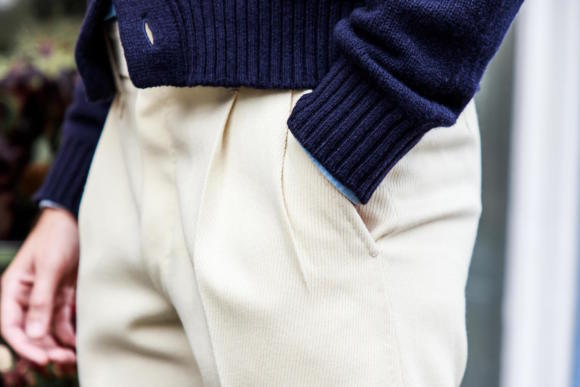
A final point is pilling. Cloths that are looser and not suited to trousers are more likely to pill.
A little trick to test this is to take the cloth between your finger and thumb, gently rub it in circles 10 times, and see if a little fluff comes off, in a messy way.
This is a good indicator that the material will pill later, particularly where there is most abrasion, for example between the legs.
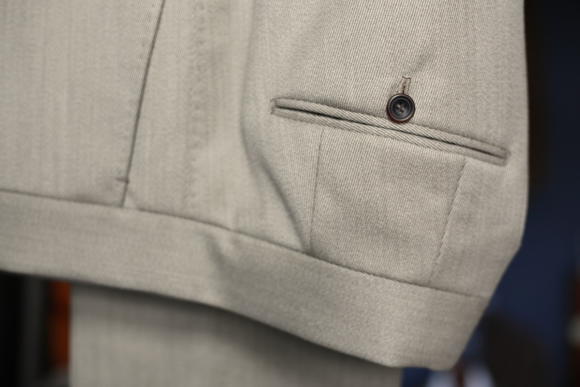
So, with all this in mind, here are the key types of trousers.
The most noticeable absence is hard-finished worsted wool (standard suit cloth). This might hang well, but style wise is usually too shiny and hard-finished to look like a separate trouser.
Whipcord
A particularly dense wool twill. (In general, you can tell the density by how vertical the diagonal twill line is.)
Great body and shape, the only downside being a tendency to look a little old fashioned, and therefore often better in darker, formal colours. Feels thick, with body, rather than thinner and harder like gabardine.
Covert
A version of whipcord more commonly used for coats, but also good for trousers. Partly defined by country colours – brown, tan, green – and different yarn colours (often visible between the twill lines). Has a tendency to be shiny; matte versions often better, more casual and versatile.
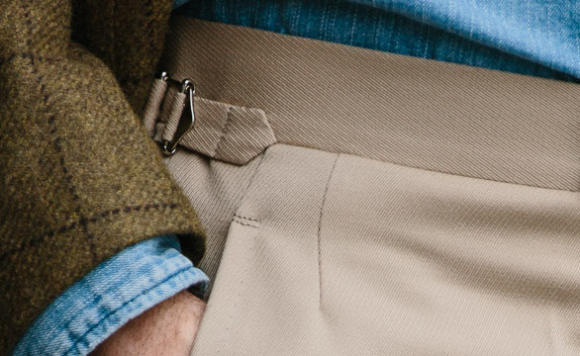
Cavalry twill
Whipcord with twill lines running in pairs. Often a little more matte in texture as well.
Serge
French for twill, and a phrase not often used because it became rather broad. Generally, refers to a wool twill that has a slightly woolier finish without being milled.
Bedford cord
A hard-wearing cloth with the appearance of the same vertical ridges as corduroy. It’s woven differently, however, and looks different for the spaces between the ridges and faint lines running between them. A good, denser alternative to corduroy.
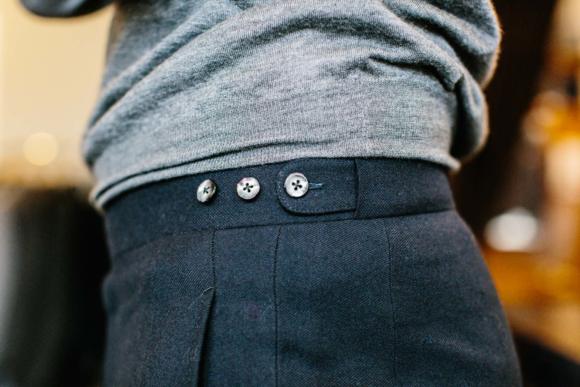
High twists
Cloth that uses a yarn that is twisted to give it strength and crease resistance. Usually the default for formal trousers in warm weather. The summer equivalent of flannel, though a little smarter.
Flannel
The universal favourite for separate trousers, because it nestles so nicely between formal and casual. Fine with a sweater, a tweed jacket or a navy blazer. Defined by its milled finish, which explodes the fibres and causes a fluffy appearance.
Gabardine
A warp-faced fabric with a high density. Traditionally in lots of yarns and finishes, but today generally in a fine yarn and hard finish, which makes it sleeker and shinier, similar to suitings. It is usually too formal for me as a result. Most plain cottons used for tailoring are gabardines, however.
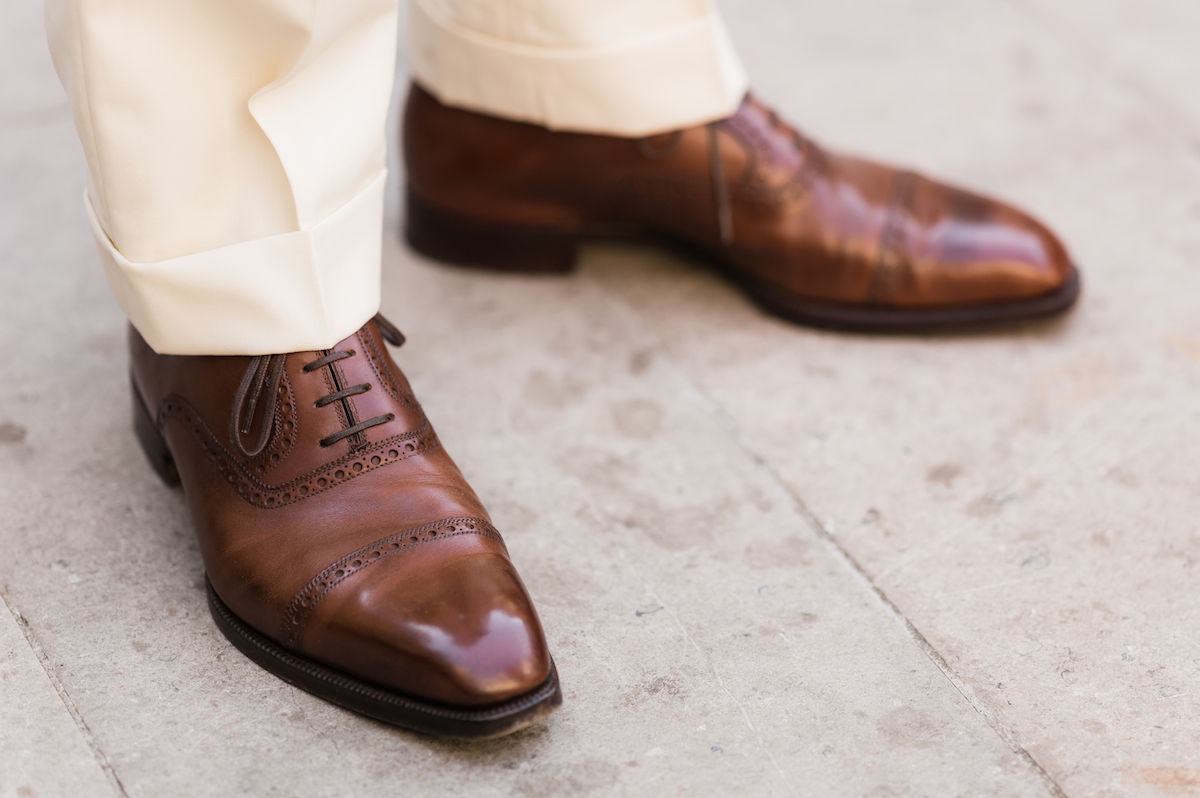
Corduroy
The distinctive weave (actually a type of velvet) with vertical ridges. Nearly always cotton, but also wool. In a good weight, with no cotton or elastane, makes good trousers. But perhaps more subject to the vagaries of fashion than the wool twills.
Moleskin
A cotton twill with a brushed finish. Warmer and cosier, and therefore mostly used for winter. Again, subject to fashions: often seems a little old-fashioned today.
Chinos
Not a cloth at all, but a style of cotton trouser. Usually uses a cotton twill, but otherwise varies hugely as to how the cotton is woven. Can be stiff and sharp, even shiny; or can be soft and washed. In the latter case (most common in high-street shops), largely gives up the ideals of drape and body.
Denim
A cotton best defined by its 3-by-1 twill and indigo colour. But can be in a huge variety of weights and colours, even weave structures. Denims used for tailoring are generally finer and denser, in order to achieve a bit of that drape. Which is why they look nothing like jeans.
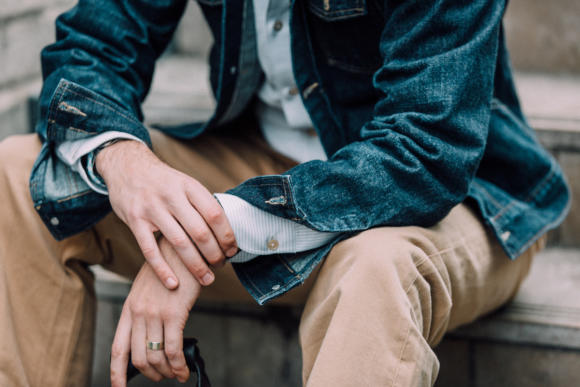
As ever with describing cloths, there are the original, narrow definitions and then there are modern uses.
Often the definition describes only one part of the process (such as weave or finish) but it takes on other aspects over time (eg is a worsted flannel really a flannel?). And then there are cultural associations (such as with serge).
I find the key thing to remember is – when you visit a tailor – to know the kind of cloth you want (heavy/light, dense/loose, casual/smart) as well as the name. There will always be variations and exceptions.
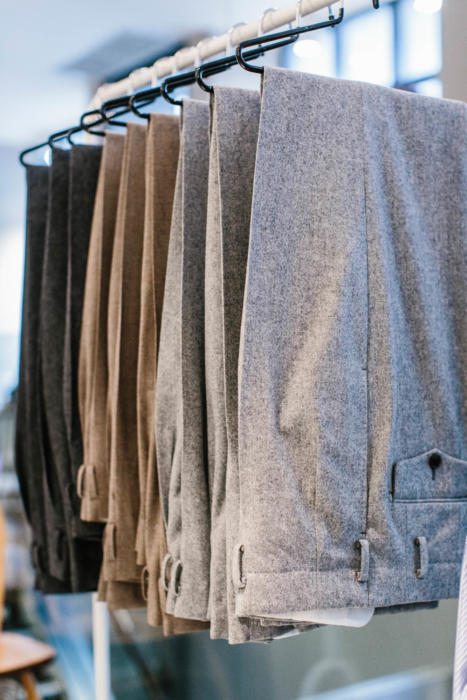


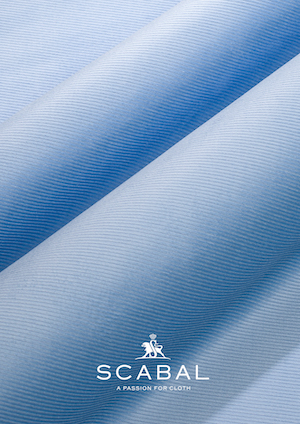
Where are those workwear chinos from?
The Armoury. Unfortunately not made any more
This is very usefull, but, and please excuse my ignorance here, but you didn’t mention tweed. Is this already covered under one of the other headings? Thanks.
No, you would just generally not make trousers out of most tweeds, as they’re too loosely woven. There are exceptions, but at that point they’re really wool twills coloured like tweeds
Hello Simon,
very interesting post. I have a further question on tweed trousers: Is the problem with the loose weaving that the trousers can become baggy at the knees? I wonder what this means for tweed suits with normal trousers (as opposed to plus fours, where this would perhaps be no problem), e.g. from Cordings: Will the trousers change their form over time? This would be a pity as I like this combination.
Thanks, Michael
Yes, the issue is losing shape, so bagging but also losing any crease, and not having a sharp line when worn.
That said, as mentioned in the comments above, it depends on the tweed – some things are much sharper and denser, but some people would say at that point it’s not tweed anymore.
If there’s one hard rule, it’s that if you use a tweed that’s designed as a jacketing, for a suit, the trousers will not perform as well.
Genuinely useful post. Especially as I go to have a pair of trousers made for me this afternoon. Have a feeling this is going to become something of a big legacy post for the site. Thankyou Simon!
Simon, apologies if my memory is awry, but I think I remember a very, very early PS post where you wrote that trousers were one of the least worthwhile items to get made bespoke, considering the cost compared to getting a good pair of RTW adjusted. That was years ago. I wonder if you still think this?
Yes I still think that’s accurate – see this post
https://www.permanentstyle.com/2015/08/what-is-worth-being-made-bespoke.html
Do you think this advice on altered RTW still applies if you are something of an odd shape (I’m 36” waist, but only 30” leg)
Yes, largely. You might just have to hunt around a bit more for shapes that – or perhaps go for MTM. Unlikely to absolutely need bespoke though.
Hi Simon,
What do you think of wool-mohair blends for trousers? Are they a good durable option?
Best,
Bryan
They’d certainly be durable but I’d only go for them over wool if I wanted the particular look of mohair – crispness, often a little sheen
from my experience be careful with mohair, I’ve heard it described as the ‘diamond fibre’ and such like glowing praise. however as Simon says, its very very crisp so looks ultra formal, more so than even a worsted, that makes it difficult to wear more casually if you had say a sport jacket or trousers made from it. also what people dont discuss so much is that while it is hard therefore has strength in this respect its ‘hair’ and therefore can it can stretch and bag so in a jacket you may need reinforcement in the making, and trousers could I imagine be an issue around the crotch.
I have a pair of a pair of wool mohair trousers. I think the fabric is Vitale and they are very nice. Little sheen, but keep a nice crease and are lovely in the Spinrg/Summer.
Very useful, thank you.
1. Under corduroy, after noting it is typically made of cotton, you write that it is best “with no cotton”. Was that a typo and you meant to write something else? I’m assuming you aren’t against cotton corduroys.
2. When you discuss the density of cloth to ensure good drape, is that largely about the set, or is it also about the density/weight of the yarns themselves?
1. Yes, sorry a typo. Should say no lycra or elastane
2. The set. Yarn can be thicker or heavier but it doesn’t have to be densely woven together
I wish there was more wool corduroy, I’ve seen it in RTW but rarely ever in cloth for mtm/bespoke
Simon you would actually be wrong on the elastane or similar point. Pretty much all the cord coming from the big houses has a very small element built in.
The bunches I buy trousers from all say 100% cotton – whether Scabal, Holland & Sherry, Brisbane Moss. There are some with elastane, some without.
Are you suggesting they have elastane in even if they say 100% cotton?
Hello Simon,
another really nice post indeed.
Question (that could make it in its own post): How much fabric does one need for different tailored garments?
Let’s say a pant, a jacket, a waistcoat, a suit (both 2 and 3 pieces), a full length overcoat and a pea coat (each taken individually)?
How much influence is there in the person’s measurement there? What’d be the difference between a 5’3″ tall / 38″ chest and a 6’4″ tall / 52″ chest man?
The question comes as I recently was in a cloth store, and realised I have no clue what I need for myself, or a friend of mine for that matter.
It’s a good question, but there’s not much point in listing lengths here, as it will vary so much with height and weight of different people. You need to ask a tailor and then write them down for future reference.
When and who changed the trousers tomorrow leg width or skinny .
Now all my dress slacks are out of fashion
Hi Simon,
Thanks for a great article. I wonder whether you have any experience with side adjusters working better or worse with different trouser fabrics. On a pair of lighter woolen trousers, the adjuster simply don’t catch, and are essentially purely decorative. Is it a case of getting better adjusters? Or are there adjuster types that work better on some cloths and not others?
I think it might be an issue with the particular type of adjustors. The only issue I’ve had is on thicker fabrics where the cloth won’t fit through twice. But on lighter fabrics it should always be fine if the adjustor works
Thanks! You don’t happen to know where I might source some replacement adjusters that are sure to fit the bill?
No, sorry. Best to talk to the company that made them – they will have better sourcing options (and indeed, should bear responsibility for those things being functional)
Hi Simon
I was interested in your recent article in the Robb Report in which you referred to the pleasure of wearing linen trousers in warm weather and recommended going for 11 ounce material. I notice that Anglo Italian offer 7 ounce trousers and Drakes 12 ounce. In the context of your article today what would the experience of both clothes be ? How often would you bother to get such trousers pressed ?
Thanks
Paul
I’d go with 12 ounce – the difference there isn’t much, but you will notice it between those and 7 ounce.
I’d only press them once or twice a season. But I might iron the creases back in myself once or twice too.
I think you aren’t a huge fan of cotton trousers, but what weight (and weave) should I look for in a 3ish season wool fabric for trousers?
I like them, it’s just hard to find good cloths for them. In regards to wool trousers, something around 11oz would be fine for most seasons except summer in the UK, but it does depend a little on personal preference. And twill will usually be the best for keeping a hard line. But finishes vary, and other weaves are good too. I’d look more at the terms above and see whether you like examples of them – such as cavalry twill or flannel for example
Hi Simon,
Enlightening post.
Based on your previous comment about trousers not made of tweed but of tweed coloured wool twill, I wonder what are tweed suits made of? Are they made of “real tweed” or wool twill made to look like tweed? If they are made of real tweed, are they effectively rather fragile and likely to last far less than the jacket?
There are no absolutes here – no clean definition of tweed, and tweed suits will usually be made of a wool (like tweed) that is merely a little denser and sometimes finer, sometimes worsted, so it makes better trousers. The Thornproof bunch from Porter & Harding, for example, is dense enough to make a great suit. But it isn’t what some people think of as tweed
Great article, thank you. Any suggestions for chinos formal enough to work with tailored jackets?
Drake’s, Anglo-Italian, Stoffa, Anderson & Sheppard
All the above make a relatively narrow style. Do you know any rtw quality chinos if a classic 18″ wide bottoms?
Even though linen is mentioned in some of the subtext, it might be an idea to add it as a bolded option as well, I think that’s a more obvious fabric missing than regular wool suiting.
Sure. It’s also covered more in the following article in the series, on summer trouser cloths (See contents for this Guide)
I am looking for a pair of tougher workwear chinos and would like something like the (discontined) army chinos from the Armoury. Do you have any recommendation for something similar?
I haven’t tried that many, and the Armoury ones are by far my favourites, but worth looking at Brycelands (very high rise), Informale (still fairly high rise), Blackhorse Lane (mid-rise) and workwear brands like The Real McCoys etc. Most will be fairly big in the leg, so watch out for that
“And then there are cultural associations (such as with serge)”
what did you mean by this Simon? Serge is associated with what exactly?
Serge for most mill technicians just means a twill (in French). But it is associated with a certain weight of woollen, slightly unfinished, and often in navy
yes but what did you mean by ‘cultural associations’ of serge? A certain group wears them? Older crowd or something?
No, I merely meant what I said about a particular weave being associated with a final design of trouser. It is not associated with different parts of the culture; but the culture makes certain associations of the weave with a type of trouser. In the same way you a culture might assume a Mackintosh is of a particular design and colour, even though it’s just a company.
Hi Simon,
Thanks for this very useful post. Eventually, an opportunity for me to ask you a question about serge. Which are the mills that produce its heavy version? Up to now I’ve googled with no success.
Thanks in advance for your help.
John
I have some from Fox. I don’t know any others, but if other people do, I’m sure they’ll chip in
Simon, on your homepage there is a photo right at the top titled ‘the sagan loafer’. What trousers are you wearing there? are they the same as ‘pale grey high twist’ in the first photo in this blog post?
You’ll have to send me a screenshot next time you see it zohair. Those images at the top of the homepage rotate through a very large number – they’re different every time you visit or refresh
Thank you for the useful information. In the same fashion of the article above, could you elaborate on ties, pocket squares, shirts, socks etc. , I trust it would be as much useful and fun to read as the above.
Best,
Have a look at the sub-sections of the menu – under Guides you’ll find extensive information on shirt cloths. And under Style (on a desktop) you’ll find a section on Wardrobe Building that covers some of the other areas too
Just a thought but maybe a capsule collection post on trousers and some tips when commissioning them specifically could be useful.
Thanks John.
There are these posts on trousers if helpful:
https://www.permanentstyle.com/2014/03/trouser-colours-to-wear-with-odd-jackets.html
https://www.permanentstyle.com/2018/04/trouser-measurements-style-and-proportions.html
https://www.permanentstyle.com/2018/04/filling-the-gaps-six-pairs-of-odd-trousers.html
All in the ‘Trousers’ category
Simon, I’m not sure I get that right: do navy trousers work with an odd jacket depending on their cloth (a serge like you have here, or a donegal, cotton or other more casual cloth) , or should it generally be avoided?
They’re generally not that versatile and should be avoided.
Simon, as usual a very informative article. I’ve one question out of my own experience. I’ve had several trousers made with side fasteners, i.e. no belt. After wearing a few times a crease builds on the waistband at the front, where this gets folded when sitting. Is this normal, or do some tailors add some kind of an insert in the waistband to prevent this happening?
I think this is normal on any trousers Edward and unrelated to having side fasteners. The only solution is to cut the trousers differently, eg by having a lower or higher front rise
Hi Simon,
Would you have any recommendations for covert or whipcord bunches?
Dakota from Holland and Sherry
Hi Simon, I just wanted to know more about wool-mohair blends and if they make for good separate trousers. I’m looking for something not too light and will be crease resistant. Would be great to hear your thoughts!
Hi Bryan,
They can be good, but you also get a specific look, even with only half mohair. Very crisp, slightly formal looking. I’d go for a high-twist wool instead if you want light and crease resistant. Like Crispaire or Fresco
Simon, would you help me with identyfing a particular trouser material? Yesterday, during a secondhand clearance I managed to get something unusual. A pair of dark tan 100 cotton trousers. Flat front, crease, 3 button tab waistband, 5 pocket cut. The material is fairly thick and heavy, it seems to hang well. The weave is big and visible, but it does not look like the usual chino twill – the ribs don’t line up. It looks more like plain weave. For sure it is not corduroy, but the material seems pleasant and soft. Could it be moleskin? I’ve never had any, so I can’t compare, but then you said it is also a twill.
I’m afraid it’s pretty impossible to tell Karol without seeing them, sorry.
Hi Simon, what are the advantages and disadvantages of fully, half and unlined trousers?
Lining is mostly there to make the trousers move more easily against the cloth, and so help the trousers retain their drape.
It’s also partly about warmth – some dislike it for summer trousers because a half lining (in the front, to the knee) is slightly warmer, and some have it on winter trousers for warmth.
But full linings are a pain – making them hard to press or retain their crease in the right place. I’d avoid them.
And I’d only have no lining on summer cottons, perhaps linen. Otherwise, 95% of the time, have a half lining.
Excluding denim and cotton chinos, what 5 pants would you wear for fall/winter? I’d be interested to know the color and material you’d choose. Thanks
Well, it depends on a bunch of things, including how formal your working environment is etc.
But for what I wear, I’d say my five would be:
– Mid-grey flannels
– Charcoal flannels
– Char-brown flannels
– Tan or cream cavalry twills or whip-cords
– Olive green corduroys
Thanks good to know.
what if you’re aiming for #4/5 in ‘Which Office Are You?’
and # 2/3 in ‘Which Sports Jacket Office Are You?’
knitwear is also possible.
I’d probably pick the same trousers – the only possible change being maybe swapping the charcoal flannels for another cotton in a less formal colour. Say another corduroy in dark brown or tan
Do you have a olive green corduroy fabric to recommend?
Not specifically for trousers, no. I’d look at Brisbane Moss bunches first though.
What weight would you recommend for Winter cord?
Something around around 12-13oz, around 350g. But it’s mostly about style and line of the trouser – it won’t make a big difference to cold unless you’re somewhere like Scandinavia or Northeast US
Hi Simon,
I have noticed Fox Brothers have produced a cavalry twill in dark green. I happen to have the ecru version which I enjoy, so am thinking of perhaps getting this as well, as you always talk about dark green being very useful. My question is, should I go for the cavalry twill or perhaps go for a flannel dark green?
Nick
I think you’ll probably find flannel more useful – I do
Given it’s not easy to find an ideal balance of rise/thigh width/leg openings, do you think it’s a great idea to commission a bespoke “workwear chino” if cost is not a concerned?
And what in your view is the best fabric for workwear Chino?
Thank you Simon
Not usually Ben, for a few reasons. First, the kind of fabrics available to tailors are not the right ones for workwear chinos – they’re dressy materials, designed for dressy clothes. Normal chinos are made in materials that are bought in bulk, and not sold by the length.
Other issues are that chinos are often garment washed, which a tailor won’t be able to do. And also that some materials are too stiff for them to work with effectively.
You’d be better trying to find factories that would do made to order.
Your insight is greatly appreciated Simon!!
Great insight! Just one more follow up question – for the cream denim and the rusty corduroy trousers that you suggested once in your other posts, do you think commissioning bespoke for them is alright?
Sure, you can get both in bespoke. With cream denim, if you mean actual jeans then I would go with something like the Levi’s Lot No.1 bespoke service
I just bought a pair of MTM chinos in garment washed cotton from Saman Amel. I am very happy with them.
Thanks Carl. Were they garment washed? I didn’t know Saman did that.
What was the material?
In some kind of cotton, I am not sure about the technical term for the weave. Maybe a twill. It feels like a garment washed chino from Incotex but better detailing and of course much better fit. I think they said that it was made in another workshop than the one they use for tailoring.
It is quite new for the season. The structuew
And yes, they are garment washed and you can throw them in the washing machine. I guess that Saman or Dag can give you the details.
Great, thanks Carl.
Spencer’s/northern men’s and boys wear two made to measure services.. Go to Brisbane moss look up flat cotton, any canvas, drill (Tennyson bunch or the rye cavalry twill will do. As for the garment washing process, that’s silly you do that yourself when you wash them. Yes they may look a bit shiny to begin with but after 20 washes that will go. Tennyson is usually used for suits but it is a cotton drill so will work well for workwear.
Hey Simon, wanted a little advice on separates if I’m going for a fresco mid-weight trousers what kind of fabric jacket can I pair them up with
Hey Ehsan,
You could wear them with a huge range of jackets – fresco is very versatile. In fact, it’s hard to think of anything you couldn’t put it with, except cloths that aren’t meant to be jackets (suitings and most worsted wools) and perhaps heavy winter jacketings, as your body would be rather warmer than your legs.
Were there particular cloths you had in mind?
Hi Simon. I hope you are having a nice weekend. I will be getting a corduroy suit in a navy color. When I want to use the jacket as a separate, is flannel a good choice for trousers? In a light grey? What other types of trouser fabrics go well with a corduroy jacket?
Yes, flannel could be good – probably in a mid-grey. I would also look at other cottons, and perhaps denim
Hi Simon,
Love your post! Just wanted to ask what type of trousers would you recommend for a person living in ‘India’ which is neither casual not very formal?
Posted this question because it does not get very cold over here and therefore flannel would not be a very good choice
In that case I think you’d be looking at cotton trousers – cotton gabardine – or linen.
Hi Simon, I am always putt-off the idea of vintage jeans, as I feel like they have been worn in by someone else and therefore moulded to someone else’s body. What is your experience of finding vintage jeans that fit? Did you get them altered?
Hi Nick,
I can understand that feeling, but it doesn’t matter to me. I’d happily take second-hand clothes as well, or things a friend or family member might give me.
Also, with vintage jeans, most of moulding has been worn out, they’re so soft and often lightweight. The markings are there, but not much of the shape.
I didn’t get mine altered.
Simon,
I’m looking for your advice regarding flannel and bespoke fit. I recently blew out the crotch on a RTW flannel (my only pair, so no previous personal points of reference). I’ve got large thighs and butt relative to my waist. How much do you think the blowout was a result of RTW fit, or of flannel’s delicacy as a material? Do you think a bespoke fit would prevent this; would heavier wooly fabric be the way to go; or should I just go with high-twist from her on out?
Thanks
Hey Hugh,
It’s hard to tell without knowing how you’ve worn the flannel, and exactly what the fit was like on them.
Flannel isn’t too bad for wear, until it gets wet, at which point it gets pretty delicate (like a lot of wool). So if you sweat into it a lot, or ride a bike in it, then that will do it for flannel. No make or fit will make much difference.
And regarding fit, it depends how tight the trousers are through that area. Bespoke will give you whatever fit you want, but it depends how much of a problem the fit is on the ones you have.
Also, it is worth seeing if you can patch the flannels, particularly if it only has to be on the inside.
Thanks, Simon. I think sweat was the issue. I tried a patch, but the fabric was by then too flimsy and it re-tore along the stitch line.
When W&S start travelling again, I will discuss with them. I might also ask about a grey cavalry twill (flannels are less ubiquitous generally here in the midwest US)
There’s a nice grey twill, a whipcord, in the Holland & Sherry Dakota bunch that’s worth a look in that regard
Hi Simon,
I’m looking at getting some odd trousers, and I’ve a grey, high twist, 60/40 summer kid mohair & super 100’s from Taylor and Lodge in mind. Might the natural lustre/sheen of the mohair make these difficult to pair well with odd jackets or a blouson?
Yes. They should be OK with odd jackets, though a little smart. But I wouldn’t wear them with a blouson probably.
Simon, I am wondering if you have a preference between mid and light grey flannels? I realise this is a very general question. But, all other things being equal, which would you say offers more versatility?
Mid-grey
Hi Simon. I hope you are doing well. For trouser waistbands, do you prefer hook and bar or button? Does it depend on the type of trousers? Or both options are good for most types, just a matter of personal preference?
I am having grey flannel trousers and also stone colored cavalry twills made. My tailor asked which type I wanted. It was actually something I never really thought about before, so I wanted to ask for your opinion on it. Thanks in advance!
Hey – we go into it in our trouser style chapter of the Guide to Suit Style, here
Hello Mr. Crompton,
I need a bit of advice:
I am looking to expand my collection of odd trousers. Collection is actually a bit of an overstatement (so far I have a Charcoal Flannel, as well as a Beige and a brown High Twist. Next I have my eyes set on a Cream pair of Cavalry Twill, preferably to be worn year round.
Now my question:
Should I go with a cotton or a woollen Cavalry Twill?`
Thanks in advance!
Hi Johannes,
Given the size of your collection, I’d suggest something like a mid-grey flannel or a dark-green might be more practical, but cream would certainly be nice. Cavalry twill is usually wool, and that’s what I would go for.
Thanks
In regards to corduroys being best with no elastane, do you feel differently when it comes to chinos? I notice you mention Incotex a lot, but when I’ve looked they all seem to have about 3% elastane. A lot of other brand seem to have 2% elastane too, it seems quite difficult to find 100% cotton ones.
I don’t really mention Incotex that much any more – I haven’t worn them regularly for a few years now. So no, I’d still generally recommend against the stretch
Fair enough, I’m still a fairly new reader and I read a lot of articles without looking at the date! Are there any places you’d recommend for RTW chinos? From my searching I found that Cordings do quite a wide colour selection.
They do. The style is pretty old-fashioned, but it you get them altered they can be good.
Anglo Italian (the garment washed line) and Drakes seem nice.
Personally, I still like Incotex chinos but I would classify them as a smarter alternative to jeans rather than a more casual alternative to tailored trousers (if that makes sense).
They are nice indeed, unfortunately I’m not yet at the level of income where I am willing to spend quite that much on OTR cotton trousers.
What is the price range? That is the information we need as potential customers. I have been trying to find the catalog,
Sorry Teddy, you mean price range of the cloths themselves? The vast majority of the time, you wouldn’t be buying the cloth yourself, but rather the tailor would – and often at a different final price
Hi simon,
I wanted to know what kind of finishes is given to the fabric at the garment stage on the basis of durability or any physical or chemical finish.
Happy New Year, Simon
I am looking at whipcords to have trousers made and I am somewhat puzzled by HS’s offerings from their Dakota bunch, which I know you are very familiar with.
I draw from both the Jackets /Trousers guides that for one and the same cloth, looser is more advisable for jackets, denser for trousers.
I am all for heavy cloths for trousers in order to favor drape, heat not being an issue.
Now, HS classifies 10 / 11 oz whipcords for use in suits:
https://apparel.hollandandsherry.com/en/fabric/use/suits/9518301-dakota-tan-whipcord
While 13 oz whipcords are classified for use in jackets:
https://apparel.hollandandsherry.com/en/fabric/use/jackets/9518500-dakota-fawn-whipcord
For added uncertainty, the example dummy for both only features trousers.
Would you expect the 13 oz to make good trousers? So I would from a twill in that weight, rather than the lighter ones. Or would you fear the “stiffness” drawback?
Thanks,
I think they’d both make good trousers Nico. I’d ignore the classification from A&S. Given the image, it might even be a mistake.
Hi Simon,
Any thoughts on using 350g canvas linen for a trouser? I’ve got some Cacciopoli swatches here and a beige one looks nice to me. I’m just worried about the suitability of canvas linen instead of delave linen for trousers.
That does sound nice. What someone calls a canvas will vary, so it’s hard to know exactly (I haven’t seen those swatches). But I like the idea of a linen that is more densely woven, or stiffer, as canvas usually is.
Delave linen isn’t necessarily the alternative, but different again, being a washed effect. Most linens will be neither delave or a canvas.
Thanks a lot for the reply appreciate it!
Any thoughts on the versatility of beige vs light-beige? I’m torn between the two. I’m a little weary of drawing too much attention to myself and I think the light beige looks a bit too flashy, but i’m willing to risk it for the sake of versatility.
The shirts I have are made from the Oxford cloth from the PS Shop (blue, ping and the chambray).
I think lighter beige might be more useful. Nicest with white and light blue shirts. As shown in this post
Hi Simon, I had a question about the hardiness of certain fabrics for trousers, piqued by the review of your latest Sexton brown linen suit.
For smart trousers that will cope with near-daily wear, tailors that I’ve worked with have consistently recommended high-twist wools. Consequently, my wardrobe is stocked with Fresco and Crispaire pieces in various colours for regular rotation. This works, because living in a temperate/subtropical coastal city, there is little call for heavier flannels, even in the middle of winter.
Could I please ask you for an opinion on the relative robustness of a heavier, Irish linen for tailored trousers as compared to something like Fresco? I wouldn’t be wearing it every day, but where I am a heavier linen could do quite well for up to three seasons per year.
Many thanks for your thoughts and best wishes.
It wouldn’t wear as well as those, no. Perhaps half as well, though it’s hard to be.precise
Where can I get it
Hi Simon, I just came across your site, and I am already addicted there’s just an abundance of amazing advice here.
I wanted to ask though about that denim jacket, It’s all I can think about now, what should I search for to get that exact look? Is that raw or selvedge, whatever it is its perfect! Could you tell me where you got it? I am 5″2′ so it’s tricky to find things that fit me. If you read this then thanks!
Lovely to hear Hyam, thanks. Do leave questions as comments – it’s always helpful to others as well.
That denim jacket can be seen in more detail here.
Sorry Hyam, actually there’s no more on it there. It is from The Workers Club though
Hi Simon, after mid-grey and charcoal flannel trousers, would you recommend light grey or char-brown flannel? Which is more versatile?
Both would be good. Personally I like the char-brown a lot more, but it depends on what else you wear. The char-brown is good for me because it doesn’t look so smart, and because I like wearing black shoes. The colour isn’t as easy with brown shoes
Hi Simon, I’ve seen you recommend 13oz Brisbane Moss corduroy for trousers. What are your thoughts on the 11oz for trousers? Would you strongly recommend against using it, or say it’s good but just a bit worse than the 13oz?
As long as you like the colour range and the wale thickness, it won’t make a big difference.
Thanks. What impact would the 2oz have on warmth?
Hard to quantify. Some, but not a lot. Most of the time you probably won’t notice
Which trouser fabrics provide the most natural stretch, as well as being a lightweight summer fabric? Similarly, which fabrics offer the least stretch?
In my experience, linen often has the least. Another good reason to have it a little fuller.
True, linen is quite open usually, but also quite tough. There isn’t much natural stretch. Often cotton/linen mixes are better
As far as natural stretch, how do you rate Fresco vs Tropical Wool vs Crispaire vs Worsted Wool vs Gabardine?
It’s hard to compare them just on that basis, as there is a lot of variation – and the stretch comes more from the weave than the yarn.
But high-twist wools like Fresco, Crispaire and other tropical wools with usually have less, while gabardine and other more general worsteds will have more.
I wouldn’t focus too much on natural stretch with these cloths though. A slightly more generous cut will make a bigger difference.
Hello, Simon,
I’ve been thinking about getting three nice odd trousers, but the problem is that I would like them to be susceptible of being machine-washed and tumble dried. I’ve already got a nice pair of jeans and I’m not really a fan of chinos, so I’m wondering which (if any) of these cloths and weaves are better suited for this purpose. Ideally, I would also like my trousers to have creases, so I’d be glad if you could help with this.
Thanks!
Hi Sebastian,
None of these cloths are really designed for that kind of use. What’s more, the way pretty much every tailor makes their trousers, the lining and structure wouldn’t really be ideal for machine washing or dry cleaning.
In the end, tailored trousers like these are made with finer materials and structure, and they need better care that machine cleaning and drying, which is very hard on clothes. The same goes for shirts, knitwear, socks etc. You can’t have both.
S
What do you think are the best overall colors for pants such as cavalry twill, gabardine, and flannel?
Have you read this post?
Hi. Do you have any recommendations for a summer weight / tropical wool or high twist in cream? Try as I might, I cannot find a Crispaire, etc. in that colour.
I’m afraid not, no.
Instinctively I feel cream wouldn’t look great in a high twist like that, but I can’t quite say why.
Too see-through perhaps?
Perhaps. I feel more it might not suit the texture of the wool
Thanks. Are there any suitable cream coloured fabrics out there suitable for summer? I would wish to avoid 100% linen due to the creasing but open to other ideas. Any specific cloth merchant / fabric bunch advice welcome.
I love linen myself, and Irish linens will crease less, as will heavier ones.
You can look at wool gabardine, like the trousers here. That’s very smart, but quite light for temperature.
Splendid. Thank you.
Hi Simon,
I am looking to have some trousers made with Graham Browne and hoped to get your advice on cloth. My aim is to ultimately get two pairs, as versatile as possible, in grey – to be worn with everything in between a hopsack navy blazer or a brown Valstarino.
Do you have a go-to solid flannel option that’s easy to recommend? I’m currently looking at a mid-grey 12oz worsted flannel from Harrisons – it’s not as wooly and slightly lighter-weight so I’m thinking it could be worn all year round. Don’t have much experience there so any advice really welcome in terms of mills/bunches/etc.
Also, what would you consider to be a good weight Fresco? A Huddersfield Fresco III caugh my eye as a good summer option but wondering if it’s okay being at the 9-10oz mark. Any recommendation there also very much appreciated.
Best,
Teo
Hey Teo,
Personally I don’t like worsted flannel because it removes the point of flannel for me, given the lack of texture. But that is quite personal. I’d go for Fox Flannel myself, 13oz.
9/10 is fine for Fresco, though personally I find that two rough and I’d go with Crispaire from Holland & Sherry or the 2-ply from Drapers.
This is very useful, thanks a lot Simon!
Hi Simon,
What do you think of loden wool for trousers? I have seen some samples that look similar to flannel and were recommended to be hard-wearing.
Best,
I’ve never tried it. I’d imagine it could be good, but there’s also likely some variation in weights and densities, so worth seeing a pair made up before ordering if you can
Excellent advice, many thanks!
Wondering if you had any experience with bamboo trousers? The bamboo fabrics that I have gotten to handle feel especially luxurious and have a bit of lustre, and I was considering how they might work as a trouser?
I haven’t I’m afraid. From what I hear, bamboo performs very well. But it usually has a slight sheen that I dislike
What would be a good weight for moleskin trousers? I’m thinking Autumn/Winter use and have some samples at 300g/m2 but I’m wondering if that might be a bit heavy.
No, that isn’t too heavy. You could ever go heavier for Autumn/Winter, but that would be a good weight too
Hey, Simon! Can I ask your opinion about vbc for drapers 440g covert twill in medium grey as a trousers?
I haven’t tried that Martins, so it’s hard to say. I can’t even remember the last time I saw it in person.
But in theory that colour and material are great. Fairly smart still – more than flannels for example – but a great jacket option
Thank you!
Simon – is there a specific Fox Brothers book for cavalry twill fabrics like the cream one shown here?
No I’m afraid not – this was a one-off and they’re not offering it any more
Hi Simon,
Apologies for the hassle – probably a bit of a silly question, but I was wondering if you knew of any companies selling trousers or upper body clothing that use non-dyed natural wool? Barring camel, probably being the most accessible – I was hopeful of learning if there was anything else out there in the non-dyed category.
Thanks Simon
Yes Blake, there are a few. Look for undyed shetland sweaters, often called Voe True shetlands. Or tailoring bunches that use undyed wool, such as the jacket here from Marling & Evans
Dicks of Edinburgh,Blake.
Hi Simon, what’s your experience with moleskin re. its longevity? In trousers, but also in other pieces. I’m considering something akin to PMVC moleskin bomber and I’m wondering if it won’t wear through too fast.
I haven’t found it wears through necessarily, but it does look old quite quickly. And unlike leather or denim, I don’t think it’s a particularly attractive ageing. Even cord is nicer I think
Simon!
What is your view on chinos from Gap or Levi’s. Do you find it to be elegant with a shirt and nice suede shoes?
With RTW the main problem is how much can it b altered. Waist is easy to altered but do you think the inseam, hip and drape of it can be altered?
Usually trousers like that can be taken in, but not out
Simon, what do you think of Venetian as a trouser fabric. A number of mills eg.HFW, Dugdale etc supply this fabric? Dugdale has an interesting bunch called Invincible.
Lindsay
I haven’t tried it I’m afraid Lindsay
Hi Simon,
There’s a cracking new WHIPCORDS & CAVALRY TWILLS bunch from W. BILL. At least 19 13oz whipcords including beautiful navy’s and greys. There is one cream Cavalry Twill in the bunch also. The Cavalry Twills are 21oz. I obtained 5 swatches in a mix of navys and greys and intend to get more later. In my opinion, they surpass H&S Dakota Bunch in quality, although Dakota and indeed Dugdale’s Invincible Bunch have also more weight variation and include Bedford Cords for instance.
Thank you Lindsay. Out of interest why do you say the Bill is better quality? What do you mean exactly?
You’re right Simon.
I should have clarified that!
The colours have a refined look and depth.
For example, WB16206 is a striking light grey with very fine darker Twill ribbing and WB16216 is even more striking mid-grey with an even more pronounced contrasting light and dark twill effect, looking more like Cavalry Twill but is not. The Dakota swatches exhibit a similar effect which is a beautiful attribute of Whipcord. The cloth, IMO, has a somewhat softer handle than Dakota.
I’m no expert on this and unless you have the swatches to hand, you can’t evaluate the cloth mearly from photos.
If I may add, a jacket in one of the darker blue or navy colours with the distinct grey for trousers would seem a nice combination, but would 13oz Whipcord be too warm outside the Winter season? I’m thinking along these lines for my first commission in September:- separates, not a suit allowing versatility, durability and longevity in this commission.
Thanks
Lindsay
Thanks Lindsay, that’s very helpful.
I wouldn’t use one of these as a separate jacket myself. They’re made more for suits and trousers – they’re hard, sharper materials and not natural sports jacket material. I definitely wouldn’t have trousers and jacket in the same material.
But no, 13oz would be OK for at least half the year, depending on where you live
Thanks Simon
Hi Simon – would this be too hot for winter cream trousers in the UK?
No, I don’t think so
Dear Simon,
I am thinking about getting a pair of cream trousers made for warmer days. I came across two options – one being Huddersfield quest cotton, the other is Brisbane Moss Tennyson cotton. I think the quest cotton is softer and silkier and the B Moss one is stiffer but sturdier. Do you think any of these two fabric would be good for a cream trouser. And between the two, which would you go for?
I haven’t used either I’m afraid – what kinds of materials are they? Weave, weight etc
The B Moss is a 11oz twill and the Quest cotton one is a plain weave that’s about 10 oz I think
Thanks Tony. I had hoped there would be something else that distinguished them from other cottons. But as there isn’t there’s not much I can say about them I’m afraid, having had nothing made in either
Hi Simon,
I’m looking to create a pair of very casual summer trousers, something like a jogger trouser with elasticated waist and ankles. Its meant to be a little shapeless and airy; to be worn with untucked linen shirts on very hot tropical days.
Do you think a wool/silk/linen mix would work here?
Probably not, no. I’d go for just linen, or a wool/linen mix.
And please don’t elasticate the ankles – the waist is OK, as it won’t be seen, but elasticating the ankles looks like an odd mixture of sweatpants and long johns. No point doing that with a remotely elegant material
I like odd 🙂 Its meant to look like a beach pant. But I see why silk is going to look out of place. Pure linen it is.
Thank you
No worries. Even on the beach I’d prefer a straight hem, just worn a little shorter. But each to his own!
Yeah I’d go for pure linen, but lightweight, like an Italian one, 9oz or so
Yes, 9oz would be my guess too since drape/shape is not a consideration. Any insights on which trouser colour would work best? Mostly to be worn with navy, sand or perhaps white linen shirts, untucked.
Maybe dark olive? I can’t think of many other colours that would go with all those shirt colours. Except black maybe
Yes dark olive, then I’d say maybe another pair in dark brown. Thanks a million Simon.
Hi Simon, could you explain the difference between the cotton drill and the cotton quest for bespoke chinos. I have noticed quest is lighter and more delicate than the drill, but it isn’t easy to imagine what they would look like when they are made.
Many thanks,
Jack
I’ve never used it Jack, I really can’t say.
However, I wouldn’t use the word chinos about almost anything made bespoke, and a finer, lighter material is going to be even less like that type of trouser
Hi Simon,
I was wondering whether beige cavalry twill trousers are versatile as flannel trousers? Or would you say they are mostly for formal outfits?
Also, please find attached below a photo of the fabrics. Do you think they are cavalry twill?
Many thanks,
Jack
They look like cavalry twill Jack, yes, but it doesn’t really matter – don’t focus too much on terms and classifications like this. Understand what makes them up instead – wool, twill, sharp but often heavier.
But no, I don’t think cavalry twills are anywhere near as versatile as flannels.
Hi Simon
How versatile would you say these Fox cricket flannels are? http://www.themerchantfox.co.uk/prod/1253/trousers/fox-flannel-cricket-white-trousers
Not especially to be honest. I find they’re pretty showy, and have to be toned down by other things
Hi Simon
I wonder if linen trousers are not recommended (due to drape)? It seems to conflict with this article.(https://www.permanentstyle.com/2022/03/if-you-only-had-five-smart-trousers.html)
And would it be better to use high twist linen or Irish linen (12oz) as a fabric for trousers?
It depends how smart you want to be really. A heavier Irish linen will be smarter than a lighter one, certainly. A high-twist wool will be smarter still
Hi Simon, I know you don’t like to wear a pair of tailored cotton trousers with a tailored jacket as a separate, but would you wear them with a cotton tailoring jacket separately? For instance, beige cotton tailored trousers with navy cotton tailored jackets.
Many thanks,
Jack
Probably not, no.
Thanks, Simon.
Hi Simon,
A couple of technical questions, if I may.
I noted that H&S no longer offer the Dakota bunch, and have consolidated their whipcords/twills into ‘Seasonal Classics’.
What is the difference between a ‘cavalry twill’ and a ‘steep twill’?
How are whipcord and cavalry twill at holding a sharp crease in the legs of formal trousers?
Thanks in advance.
All these twills are steep in degrees – it means the twill line runs more vertically, and usually indicates a denser cloth that will be sharper.
A cavalry twill is differentiated by having pairs of twill lines.
Whipcord and cav twill are great for that – that’s what they’re known for.
My personal preferences for pants are blue jeans, cotton gabardine, tropical wool, linen, wool flannel, wool cavalry twill and cotton moleskin. A note on the moleskin, I tried both corduroy since everybody seems to rave about it and I did not like the feel of it at all. I vastly prefer moleskin and its softer more flannel like nap.
An update to this as I am no longer a fan of linen pants as even in a heaver weight I could not get them to drape well or look halfway decent. They also did not do that well at keeping me cool in hot weather. I’ll try cotton/linen blends if I could find them in ecru, khaki and taupe but otherwise I’ll just stick with tropical wool and cotton gabardine.
Hello Simon. Recently I’ve made a heavy navy woolen flannel blazer and I’d like to get a trouser for that. First I consider mid-grey flannel, but I’m afraid flannel on flannel is not a good idea as a seperate. Then I consider to get one from mid-grey whipcord from H&S, with one or two forward-pleats and 2 inchi cuff.
https://apparel.hollandandsherry.com/en/fabric/use/suits/9522100-seasonal-classics-mid-grey-whipcord
Do you think Is it good idea? I think I have too many beige Chino so I put cavalry Twill aside. I’d be very happy if you helped me a bit 🙂
Hey Andy,
Cavalry twill and whipcord you’d find pretty much the same, apart from the colour.
That whipcord is nice, but it would be quite sharp, would look fairly smart, not sure if that’s what you’re after.
Perhaps have a look if you can find a flannel that feels like a different texture – even a worsted flannel
Hi Simon,
This article is very helpful. However, I am still sometimes confused by the different qualities.
Does Crispaire from H & S (310g) look very different from worsted wool in trousers made (usually) for suits, or is it in your opinion a quite small difference not easily recognizable?
Kr
It depends who’s looking, but I think most people would notice the difference, yes
Hi Simon,
What will be a suitable weight for corduroy trousers to wear in a warm winter climate where temperatures rarely drop below 12C?
Rota typically uses 570g. Do you think this will be too warm? If you have recommendations for a fabric book, that would be much appreciated.
Have you read ‘A guide to corduroy’ Henry? There’s advice and suggested books in that article
The rental industry for suits at times has the challenge of offering lightweight fabric with the following specifications:
2/2 Twill
100%Wool
166 grams/meter2
Yarn number 2/90 x 1/60 Nm
Based on customer service comments. Coats and Vest have a small amount of complaints from our current customers but the trousers are ripping at the seam of the backseam. Taking into account that the customers are requesting that comfortable feel and fit my question to you is the following. Should I reinforce the back-seam with Woven fusing and 100% Polyester lining to add that extra strength in the backseam? Additionally, should I organize the loosen the pattern around the hip area?.
I think it’s probably best that you make sure customers aren’t buying them tight, and look after them well – that they know those are delicate cloths
This question may have been answered elsewhere, if so I’d love a pointer in that direction: Where/how are people purchasing fabrics if they’re the home-hobbyist tailor in the U.S.? I’m getting more comfortable making my own alterations at home, contemplating pushing myself to make some items myself but not sure where one buys the materials. Etsy? Are the “clothing” fabrics at most fabric stores good enough? I imagine maybe they would be for some low-stakes practice, but after that?
Hi Simon, do you have a go-to bunch for winter weight cotton chinos?
Hi Damian,
Not really, no, as I don’t wear plain cotton trousers that much. (I wouldn’t call them chinos either, but that’s a different discussion)
Hello Simon, for trousers I typically wear flannels in the winter, but I’m looking to expand a little. Hopefully something a bit hardier, so I was looking at twills. Out of cavalry twill, whipcord, and covert, is there one that you’d recommend over the others? I’d probably be getting something in a fairly light weight (10-11 oz).
Is covert too shiny? I was looking at something like this from VBC
https://drapersitaly.it/ke-en/collection/12047/
There isn’t a big difference really, as outlined in the article. Cav twill just has the double line, and covert is mostly about the colours and melanges.
They all have a tendency to be sharp and a little smart, even in more casual colours, but it’s either that or going for a cotton like moleskin or cord.
That VBC looks good, a nice option. I would just try and see it in person if you can (or ask the tailor) to make sure it is fairly matte
I would like to ask you, Simón, which one do you think is the chinos equivalent in winter. Sometimes is hard to find a chino that is casual enough to wearing It with sneakers or boots in winter. Would you say is moleskin or cords? Is there anything like a winter chinos, maybe a cotton/wool or cashmere blend?
Sometimes I find It hard to get a chinos that don’t look like a tailoring trousers unless I go for cheaper options like Polo Ralph Lauren.
Thank you.
Hey Dani,
You want workwear chinos, which are in a heavier, tougher material and so more casual as well as being better for colder weather. Eg the ones we covered here at Clutch – but any of those workwear brands.
Is tailored linen trousers more casual than a tailored cotton trouser?
Probably, yes, but also depends on other things like weight of the linen, colour, style etc
are pleated trousers fashion now in 2023?
Not really, no
Hello Simon, you make the excellent point that denser fabrics result in trousers that hang well, then observe sharply that cloths for womenswear noticeably lack the required density, probably because the aim is to achieve wide flowing shapes.
My further observation about mid-price womenswear is that tailored pants are often made in polyester-wool blends (more polyester).
With that as background- please do say what you would recommend as fabric for a smart ladies tailored trouser – fabric composition and weight?
I’d say I’d still recommend a pure wool, but perhaps a touch lighter if that’s what the lady wants – a worsted or maybe a gabardine
Thank you, Simon.
Hi Simon!
As usual, I find your thoughts so valuable. I tend to like dense, substantial fabrics in general.
I am always trying to look for rousers that can be worn 3 out of 4 seasons (winter through early summer, high summer is always a challenge, but I generally wear linen or shorts).
SEH Kelly has a nice pair of cotton sail cloth trousers in 13oz in a shade of navy: in your opinion, are these wearable till May/early-June? And, given their workwear style, can they be worn with light tan/beige suede loafers? Or the rule of shoes darker than pants also apply to less formal and more utilitarian style?
Lastly: is 14oz cavalry twill wool way too much for summer? I am unfamiliar with this cloth, but read so much about how nice it is for smart odd pants. Berg and Berg has nice pants for sale in this cloth…
Thank you!
I think those trousers would be wearable in terms of weight, yes. They’re quite an unusual style though, I’m not sure it’s something I’d go for if versatility and year-round wear was the aim. And I wouldn’t wear smart loafers with them.
On cavalry twill, yes it’s smart and sharp, great if you want that style. I would go lighter if you could though, and it would still be wearable into the cooler months. Do you have the option of a lighter weight?
Hey Manish, I would like to ask what your go-to cloths are for jackets and trousers in the transitional seasons in London? When wearing linens and high twists feels too early.
Cheers.